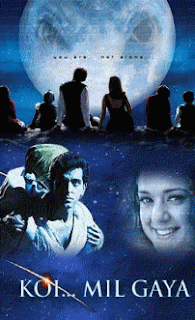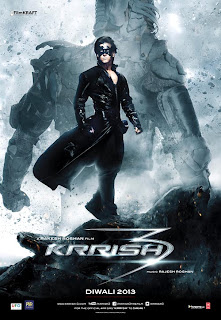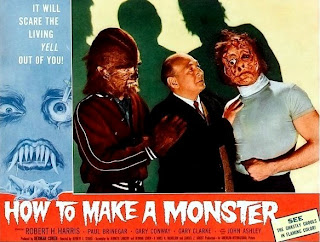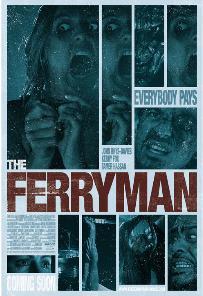Director: Tim Hogg
Writer: Tim Hogg
Producer: Tim Hogg
Cast: Jon Davey, Patrick McNamara, Nik Green
Country: UK
Year of release: 1997
Reviewed from: screener VHS
Buried away at the back of various shelves in Simpson Towers are assorted VHS tapes that I was sent by indie film-makers in the late 1990s when I was writing for SFX and Total Film. I’ve kept them these ten years or more gone by in the hope that some of them might turn out to be rare early work by successful directors. Every so often I dust one off and take a look.
I don’t recall watching Horror before although I’ve seen it on my shelf plenty of times. The sleeve is plain white with the word ‘Horror’ on it - ironically distinctive amongst all the monsters and bloody carnage on most of the stuff in my collection. I don’t know why I didn’t watch this. It’s copyrighted 1997 so I may have received it in 1998 just as I was leaving Future Publishing. And it’s taken me ten years to get round to viewing it.
Horror is a half-hour mockumentary, proving that the subgenre was alive and well even then although interestingly it had less relevance. This was before every single tiny indie film came with a Making Of. Let us remember that 1997 was also before DVDs, before internet marketing - the web was only five years old and looked very, very different - and before all the desktop edit suites and suchlike malarkey which have completely changed the face of low-budget film-making. This was a time when ‘digital’ meant you operated it with your fingers.
I would love to report that Horror is a forgotten gem. A quick Google (a verb which didn’t exist in 1997!) reveals passing mentions on various sites of a few other short films directed by Tim Hogg but Horror seems completely undocumented. However it also turns out to be largely unmemorable (so perhaps I have watched it before!) and though there is a nice idea at its core, it just goes nowhere and does nothing.
Patrick McNamara and Jon Davey play brothers Patrick and Jon Jones who live in Bristol with their mum (seen only briefly from the neck down, played by Harry Davies!) and their Grandad (Mike Fortune). Their hobby is making low-budget B-movies, something which was not nearly as common in 1997 as it is in 2008. Nik Green and Mick Scott are Nick and Mick, two thirds (director and sound man) of a BBC documentary crew assigned to follow the Jones brothers around for a few days; the unseen, unheard camera is the third member of the team.
Apart from a prologue in which Grandad plays a plumber and Jon plays a vampire, disrupted when Grandad’s ‘decapitated’ head starts coughing, we never see any actual film-making. Instead Patrick explains the merits of various types of tomato as fake blood and demonstrates to the BBC guys how to achieve horror sound effects by hacking fruit and vegetables with an axe or hammer - which gets them all thrown out of their local greengrocers. On the way home they meet Jon who has been down the pub instead of writing the script, prompting Patrick to attack his brother with a hammer then run away when Nick and Mick restrain and disarm him. Jon seems unfazed by the whole affair.
A visit to Bristol Royal Infirmary in search of human body parts from the operating theatres turns instead into a search for medical equipment in an apparently deserted ward (Mike Fortune doubles up as a heavily bandaged patient; Claire Wright is the nurse who calls security). Outside, a rummage through the hospital bins leads to an argument between the horror director and the documentary director.
After a night of heavy drinking, they all visit a butcher’s in search of offal but are summarily thrown out when hungover vegetarian Nick vomits over some chicken breasts. Finally, after a gag about Patrick catching Jon wanking when he should have been writing, the brothers receive a visit from Deaner (director/writer/producer Tim Hogg), a morgue worker who supplies them with an arm and some kidneys in exchange for (presumably) drugs. These are put in the fridge where Mrs Jones discovers the severed arm and feints. After taking their mum to hospital, the Jones brothers return home to find that Grandad has cooked them a steak and kidney pie using the kidneys which he found in the fridge...
There is lots of potential for humour here but none of it is developed. Despite being evidently intended as a black comedy, Horror turns out to be entirely devoid of actual, well, comedy. I never laughed once. I never even smiled. Sorry. Everything was a jokoid, not a joke.
For some reason the film was shot in black and white with colour reserved for clips from previous epics such as Blonde Bimbos with Big Guns and its sequel Blonde Bimbos with Even Bigger Guns (Melissa Bishop is the actress in both clips). There is also black and white footage of an incident on a previous film when an actress (Lucy Waller) refuses to be covered in two buckets of pig’s blood - which of course completely destroys the conceit of this being all footage shot by Mick and Nick.
Making indie films was a lot harder in those days and God bless Tim Hogg and his pals for making Horror but it really doesn’t work. They needed to sharpen their script considerably (it doesn’t have the improvisational appearance of This is Spinal Tap) and make sure that it had genuinely funny bits, not just stuff that had the same shape as funny. The closest it comes to comedy is the prologue, with Grandad (although we don’t yet know he’s a relative - it’s just an old actor at this point) coughing as he sticks his head through a hole in a table. Patrick hurls abuse and obscenities at the poor old git who gives it one last go and just as Patrick calls “Action!” Grandad gives an almighty cough that actually knock the table over and prompts the director to scream “Oh, for fu-!”
That’s almost funny; there’s timing there. I think it’s significant that this is the only actual ‘film-making’ on show. Perhaps if the ‘documentary’ had actually been about a film getting made there would have been some scope for comedy. As it is, the BBC crew are filming these young film-makers during a period when they’re not making a film, which seems pointless - but no comment is made about this.
Judging by the blurb on the back of the VHS sleeve, I think this was originally intended as a black comedy about two brothers who make horror films but are actually psychos themselves. There’s the curious moment when Patrick attacks Jon with a hammer and they clearly have no qualms about accepting stolen human body parts (which raises the question of why they bothered visiting the hospital and the butcher’s). But if this was the narrative intention then it’s nowhere to be seen (except on the back of the video box). The BBC crew display no horror or shock, just mild - but increasing - irritation. The whole film gives the impression of not being what its makers thought it was going to be, as if they made it with no clear idea what was going to happen.
A minimalist crew consisted of Hogg (writer, director, producer, camera, editor, music), Green (camera, music, production assistant), McNamara (production assistant), Mick Scott (production manager, editor, camera) and Davey (camera, production assistant and - in defiance of what I wrote earlier - ‘digital editing and SPFX’). The effects in question are merely muzzle flashes from a guns but that would have been very impressive and quite groundbreaking back in the heady days of 1997). Scott, Davey, Green and McNamara all get ‘additional material’ credit. The cast also includes Clare Brett, Dave Blow, Jon Wisby (who now broadcasts on Bristol Community FM) and Jacky Pranski.
Tim Hogg’s other films as director include a couple of sci-fi short: Room Service (2001, seven minutes) and The Marvellous Handshake (2003, four minutes). Also in 2003, he and Patrick McNamara co-wrote a four-minute short called The Spirit Moved, which was directed by Neil McCann and Owen Martell. He has also worked at Aardmaan in the story department on Chicken Run, in the camera department on the Creature Comforts TV series and possibly other stuff too.
And that’s about it. Not a lot else to say really. I’ve recorded the existence of Horror as a film for future generations but I can’t in all honesty recommend it because while it’s not bad - in fact the acting and direction are both quite decent - it’s simply not funny. And I very much doubt it was funny in 1997 either. Sorry.
MJS rating: C-
Writer: Tim Hogg
Producer: Tim Hogg
Cast: Jon Davey, Patrick McNamara, Nik Green
Country: UK
Year of release: 1997
Reviewed from: screener VHS
Buried away at the back of various shelves in Simpson Towers are assorted VHS tapes that I was sent by indie film-makers in the late 1990s when I was writing for SFX and Total Film. I’ve kept them these ten years or more gone by in the hope that some of them might turn out to be rare early work by successful directors. Every so often I dust one off and take a look.
I don’t recall watching Horror before although I’ve seen it on my shelf plenty of times. The sleeve is plain white with the word ‘Horror’ on it - ironically distinctive amongst all the monsters and bloody carnage on most of the stuff in my collection. I don’t know why I didn’t watch this. It’s copyrighted 1997 so I may have received it in 1998 just as I was leaving Future Publishing. And it’s taken me ten years to get round to viewing it.
Horror is a half-hour mockumentary, proving that the subgenre was alive and well even then although interestingly it had less relevance. This was before every single tiny indie film came with a Making Of. Let us remember that 1997 was also before DVDs, before internet marketing - the web was only five years old and looked very, very different - and before all the desktop edit suites and suchlike malarkey which have completely changed the face of low-budget film-making. This was a time when ‘digital’ meant you operated it with your fingers.
I would love to report that Horror is a forgotten gem. A quick Google (a verb which didn’t exist in 1997!) reveals passing mentions on various sites of a few other short films directed by Tim Hogg but Horror seems completely undocumented. However it also turns out to be largely unmemorable (so perhaps I have watched it before!) and though there is a nice idea at its core, it just goes nowhere and does nothing.
Patrick McNamara and Jon Davey play brothers Patrick and Jon Jones who live in Bristol with their mum (seen only briefly from the neck down, played by Harry Davies!) and their Grandad (Mike Fortune). Their hobby is making low-budget B-movies, something which was not nearly as common in 1997 as it is in 2008. Nik Green and Mick Scott are Nick and Mick, two thirds (director and sound man) of a BBC documentary crew assigned to follow the Jones brothers around for a few days; the unseen, unheard camera is the third member of the team.
Apart from a prologue in which Grandad plays a plumber and Jon plays a vampire, disrupted when Grandad’s ‘decapitated’ head starts coughing, we never see any actual film-making. Instead Patrick explains the merits of various types of tomato as fake blood and demonstrates to the BBC guys how to achieve horror sound effects by hacking fruit and vegetables with an axe or hammer - which gets them all thrown out of their local greengrocers. On the way home they meet Jon who has been down the pub instead of writing the script, prompting Patrick to attack his brother with a hammer then run away when Nick and Mick restrain and disarm him. Jon seems unfazed by the whole affair.
A visit to Bristol Royal Infirmary in search of human body parts from the operating theatres turns instead into a search for medical equipment in an apparently deserted ward (Mike Fortune doubles up as a heavily bandaged patient; Claire Wright is the nurse who calls security). Outside, a rummage through the hospital bins leads to an argument between the horror director and the documentary director.
After a night of heavy drinking, they all visit a butcher’s in search of offal but are summarily thrown out when hungover vegetarian Nick vomits over some chicken breasts. Finally, after a gag about Patrick catching Jon wanking when he should have been writing, the brothers receive a visit from Deaner (director/writer/producer Tim Hogg), a morgue worker who supplies them with an arm and some kidneys in exchange for (presumably) drugs. These are put in the fridge where Mrs Jones discovers the severed arm and feints. After taking their mum to hospital, the Jones brothers return home to find that Grandad has cooked them a steak and kidney pie using the kidneys which he found in the fridge...
There is lots of potential for humour here but none of it is developed. Despite being evidently intended as a black comedy, Horror turns out to be entirely devoid of actual, well, comedy. I never laughed once. I never even smiled. Sorry. Everything was a jokoid, not a joke.
For some reason the film was shot in black and white with colour reserved for clips from previous epics such as Blonde Bimbos with Big Guns and its sequel Blonde Bimbos with Even Bigger Guns (Melissa Bishop is the actress in both clips). There is also black and white footage of an incident on a previous film when an actress (Lucy Waller) refuses to be covered in two buckets of pig’s blood - which of course completely destroys the conceit of this being all footage shot by Mick and Nick.
Making indie films was a lot harder in those days and God bless Tim Hogg and his pals for making Horror but it really doesn’t work. They needed to sharpen their script considerably (it doesn’t have the improvisational appearance of This is Spinal Tap) and make sure that it had genuinely funny bits, not just stuff that had the same shape as funny. The closest it comes to comedy is the prologue, with Grandad (although we don’t yet know he’s a relative - it’s just an old actor at this point) coughing as he sticks his head through a hole in a table. Patrick hurls abuse and obscenities at the poor old git who gives it one last go and just as Patrick calls “Action!” Grandad gives an almighty cough that actually knock the table over and prompts the director to scream “Oh, for fu-!”
That’s almost funny; there’s timing there. I think it’s significant that this is the only actual ‘film-making’ on show. Perhaps if the ‘documentary’ had actually been about a film getting made there would have been some scope for comedy. As it is, the BBC crew are filming these young film-makers during a period when they’re not making a film, which seems pointless - but no comment is made about this.
Judging by the blurb on the back of the VHS sleeve, I think this was originally intended as a black comedy about two brothers who make horror films but are actually psychos themselves. There’s the curious moment when Patrick attacks Jon with a hammer and they clearly have no qualms about accepting stolen human body parts (which raises the question of why they bothered visiting the hospital and the butcher’s). But if this was the narrative intention then it’s nowhere to be seen (except on the back of the video box). The BBC crew display no horror or shock, just mild - but increasing - irritation. The whole film gives the impression of not being what its makers thought it was going to be, as if they made it with no clear idea what was going to happen.
A minimalist crew consisted of Hogg (writer, director, producer, camera, editor, music), Green (camera, music, production assistant), McNamara (production assistant), Mick Scott (production manager, editor, camera) and Davey (camera, production assistant and - in defiance of what I wrote earlier - ‘digital editing and SPFX’). The effects in question are merely muzzle flashes from a guns but that would have been very impressive and quite groundbreaking back in the heady days of 1997). Scott, Davey, Green and McNamara all get ‘additional material’ credit. The cast also includes Clare Brett, Dave Blow, Jon Wisby (who now broadcasts on Bristol Community FM) and Jacky Pranski.
Tim Hogg’s other films as director include a couple of sci-fi short: Room Service (2001, seven minutes) and The Marvellous Handshake (2003, four minutes). Also in 2003, he and Patrick McNamara co-wrote a four-minute short called The Spirit Moved, which was directed by Neil McCann and Owen Martell. He has also worked at Aardmaan in the story department on Chicken Run, in the camera department on the Creature Comforts TV series and possibly other stuff too.
And that’s about it. Not a lot else to say really. I’ve recorded the existence of Horror as a film for future generations but I can’t in all honesty recommend it because while it’s not bad - in fact the acting and direction are both quite decent - it’s simply not funny. And I very much doubt it was funny in 1997 either. Sorry.
MJS rating: C-
review originally posted 21st August 2008









































































